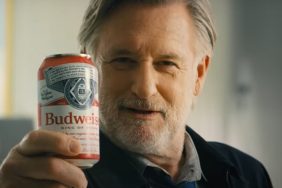At least one Christmas movie really understands us. The Darkest Hour opens Christmas Day, with the tagline “Survive the Holidays.” You think your family’s tough, the kids in Darkest Hour have to fend off an alien invasion. A group of tourists are in Moscow when aliens attack, and the survivors realize the aliens are sensitive to electronics, particularly electric lights. That gives them a chance to survive. Director Chris Gorak was the art director on films like Fight Club and Minority Report. We spoke to him about his second feature film as director.
CraveOnline: I’m always fascinated by the survivors finding supplies in whatever is left. Will I get those searches for supplies in The Darkest Hour?
Chris Gorak: Yeah, the survivors have to find their supplies for sure. But more importantly, they have to find a way to survive which is learning about the alien and the science of the alien, breaking that down and learning how to defend against the alien. So we really worked hard in setting up a mythology of an enemy coming down and attacking our world in such a way where it’s a massive invasion but it’s not perfect. Our physical world affects the aliens in a certain way and their physical alien presence affects us in a certain way. So it’s a good thing to study.
Do people tend to overthink alien weakness, like everyone complained the aliens in ‘Signs’ had a weakness to water. Do you worried that ubersmart fans will hit you with something like that?
I always look forward to those questions because I wish I had them in development, because they’re really smart. They try to debunk the science behind it but we worked hard at locking in our story, telling as much as we need to tell to tell our story. I look forward to someone poking holes in it. Let’s see if they can.
My view is if you need the planet, you have to take it regardless of what your weakness is. There’s certainly a real life example of our troops going into regions we’re ill equipped for.
Right, yeah, you think of classic war moments. When Hitler tried to roll into Moscow itself or Poland in the winter. They never got past the winter. Or people try to go into Afghanistan so a lot of those themes are in the movie, from both sides of the coin.
The electro-skeleton creature is so different from the usual toothy spiky monsters we see in movies. Do you share my frustration that so many creatures look the same?
Yeah, yeah, I know. Designing a creature is one of the hardest things to do. One, you have the history of film so you don’t want to do something that’s done before. Then I think the human brain likes to categorize things. So you design something cool and you’re like that’s cool, but it looks like a bug. That’s cool but it looks like a cat. Whatever it is, it’s hard to get past that. What we did, we were like okay, let’s try to come at it from the other way, which is our aliens are made up of wave energy. That’s their physical shield. Past that physical shield, what’s behind that? What would create that? What organic mechanical whatever thing would be able to create that? So that’s where we went and I think we got to a pretty cool place.
And this isn’t based on a book or anything, right? It’s an original concept?
Original concept that Tom Jacobson and Monnie Wills, the producers, hatched along with Les Bohem, one of the original writers. Then Timur Bekmambetov got involved and started helping us really solidify the mythology.
It’s a tough market no matter when you come out, but given the public backlash against sequels and remakes, is it an asset to say, “This is a genre you’ve seen but you haven’t seen this before?”
Exactly. We’re really excited about that part. We’re a genre movie but we’re kind of off center. We’re very unique. We have a unique enemy, in a unique location, unique cast and kind of a unique story. It feels like okay, alien invasion, but wait, I haven’t seen this before.
What was your path from art direction to forging your way as a director?
At some point in my art directing career, I realized that writing and directing would be the ultimate creative challenge. So I started writing scripts on the side and I started pursuing that goal. The opportunity presented itself with my first movie with a company called Thousand Words. Jonah Smith and Palmer West were the producers that gave me the opportunity for my first movie and really just took it and ran.
We’ve seen cinematographers and editors become directors. Is it uncommon to transition from art direction?
It’s not that uncommon. James Cameron was an art director. Catherine Hardwicke was a production designer. I worked with her. Joe Kosinski is an architect. I think the art department is a real central hub to the filmmaking process so being in the art department, you have access to all the other departments. You learn filmmaking from the inside out so for me, that part of the moviemaking process becomes second nature and then I can focus on storytelling, working with actors and other things of directing that I don’t have to overthink design or where the camera’s going to be or what the shot’s going to look like.
What are you seeing in current film art design that’s exciting you?
Right now, I think what excites me is, though there’s a saturation of superheroes and remakes and things like that, I think a lot of people are figuring out how to make men in tights look cool. I think some of uniforms, the advancement in the actual costume design of some of these films are really cool.
Like you think of the original design of ‘Captain America,’ and they had a nod to it in the movie before they brought out the revamped version.
They made the costume so it looks cool, it looks practical and it’s not men in tights. It looks like they’re doing it with the new Spider-Man. It’s great.
Does that go back to the Bryan Singer ‘X-Men,’ when he put them all in black instead of the yellow? Which now they brought back in ‘First Class.’
Yeah, because comic books are hard to translate. There’s imagery in comics that work and rules in comics that work. It’s hard to translate into cinema where it’s live action. Some of that has to do with costume design.
What were the most difficult or complex sequences in ‘Darkest Hour?’
Shooting in Moscow was really intense and then shooting Moscow but then shooting Red Square in Moscow was more intense. So these epic historical locations we were trying to control. We would shoot little pieces at a time and there’d be 3000 tourists watching us in the other direction. We’d have to map it out and then just moving around the city. It’s a huge, massive city filled with 14 million people. Just traffic alone…
Besides logistics, were there any difficult stunts or scale of action?
Yeah, there was definitely some. For our modest budget we were trying to make it feel bigger. You start getting to these sequences of action, knocking something over or blowing something up. You’ve got to shoot in a very efficient way, maybe a way that you don’t have as much freedom so you have to make some hard choices.
How many other electronic devices could you think of to indicate where the aliens were, besides light bulbs?
Oh, they affect car alarms, car lights, headlights, street lights, all kinds of stuff.
Are you proud to have ‘Fight Club’ on your resume?
It was part of my film school.
Do you find that over the years people pick things out that you’re surprised they notice?
Oh yeah, for sure. I get e-mails about “Hey, I want to get this tattoo. I want it to look like the graphic on the soap.” Something like that, it’s pretty wild.








